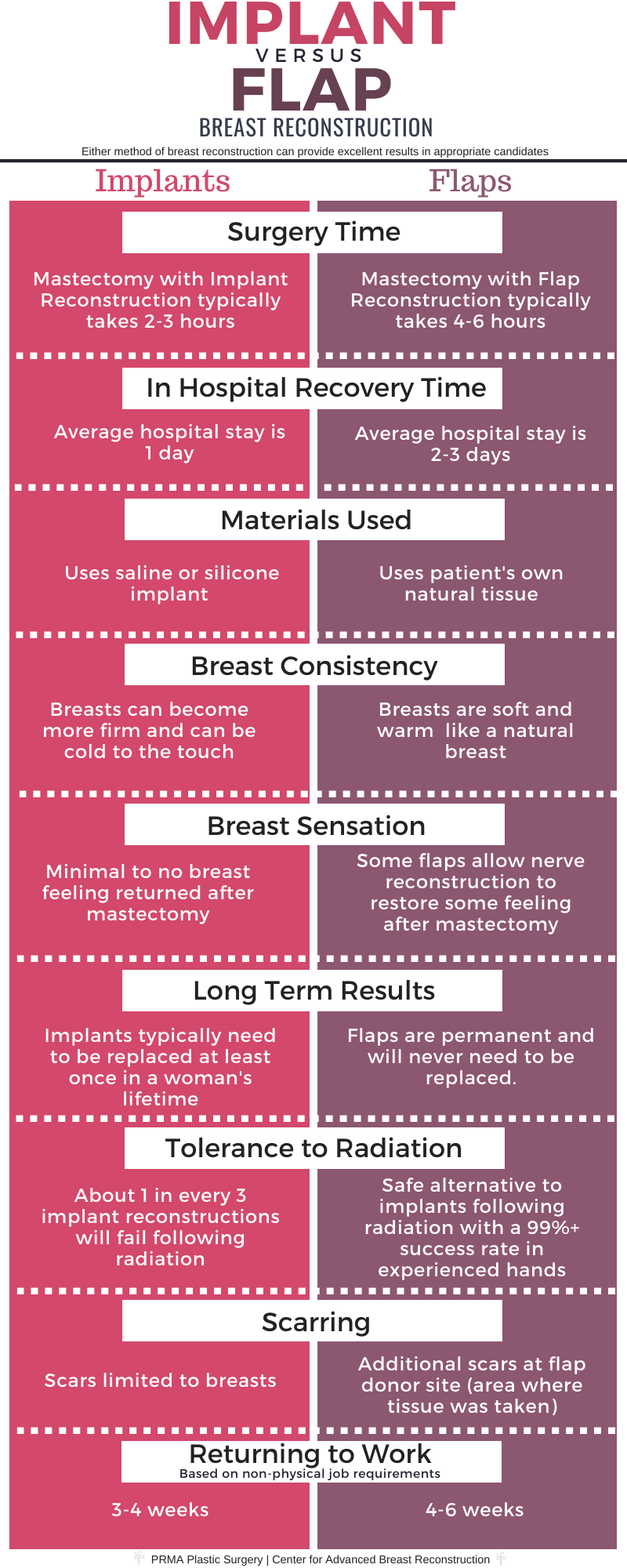
- 2 Comments
- PRMA Plastic Surgery
When you’re facing breast reconstruction, the choices can feel overwhelming—and the terminology alone can be confusing. Many women find themselves wondering: Is DIEP flap the same as breast reconstruction? Or are they different options altogether?
Whether you’re recently diagnosed, preparing for a mastectomy, or dealing with complications from implants, understanding the differences is essential to making a decision that’s right for you.
In this article, we’ll break it all down, so you can move forward empowered, informed, and supported every step of the way.
DIEP Flap vs. Breast Implants: What’s the Difference?
When it comes to breast reconstruction, DIEP flap and implant-based procedures are two of the most common options. Both aim to rebuild the breast after mastectomy, but they do so in very different ways—and each comes with its own set of benefits and considerations.
DIEP flap reconstruction uses the patient’s own lower abdominal skin and fat to create a natural-looking and feeling breast. The abdominal muscles are preserved, and the tissue is transferred using advanced microsurgery. This procedure is often ideal for patients seeking a long-term, natural alternative to implants—especially those who want to avoid foreign materials or have experienced implant complications.
Implant-based reconstruction, on the other hand, involves placing a silicone or saline implant under or over the chest muscle, either at the time of mastectomy (direct-to-implant) or in a staged process using a tissue expander. This approach may be suitable for patients who aren’t candidates for flap surgery due to medical or anatomical reasons, or for those who prefer a shorter initial surgery.
Surgery Time and Procedure Complexity
DIEP flap reconstruction is a longer and more intricate surgery because it involves microsurgical transfer of tissue from the abdomen to the chest. Implant-based reconstruction, on the other hand, is typically faster and less complex. In direct-to-implant cases, surgery can be completed in a shorter time, but patients should be aware that implants may lead to additional procedures down the road.
Recovery Time
Because DIEP flap reconstruction requires healing at both the chest and abdominal donor sites, recovery generally takes six to eight weeks, with a short hospital stay in the beginning. While the recovery is longer upfront, patients often enjoy stronger long-term satisfaction and fewer revision surgeries.
Implant reconstruction usually involves a quicker initial recovery of about two to four weeks. However, implants often require future maintenance or replacement, meaning recovery can stretch out over multiple surgeries in the following years.
Breast Sensation and Feel Post-Surgery
One of the most significant differences between these approaches is how the reconstructed breast looks and feels. With the DIEP flap, the breast is rebuilt using the patient’s living tissue, providing a more natural appearance and softness. PRMA also offers TruSense®, an advanced technique that helps restore meaningful sensation after surgery—something implants cannot provide.
Conversely, implants can restore shape but not sensation, and the breast area typically remains numb following mastectomy, with a feel that is less natural than living tissue.
Scarring and Incision Sites
DIEP flap patients will have incisions on both the chest and the abdomen, leaving a horizontal scar across the lower belly in addition to the chest scars. Many women consider the abdominal scar a worthwhile trade-off since it creates a tummy-tuck-like contour. Implant reconstruction involves only chest incisions, so scarring is more limited. However, the absence of a donor site also means no added body contouring benefit, which can be an appealing part of the DIEP flap approach.
Discover the Best Breast Reconstruction Option for You at PRMA
Whether you’re considering DIEP flap reconstruction or implants, finding an approach that aligns with your body, health, and long-term goals is the most critical factor. DIEP flap offers a natural, lasting solution that can even restore sensation, while implants provide a shorter initial surgery but may require more maintenance over time.
We’re here to guide you through every step of this journey with compassion, clarity, and expertise. If you’re ready to explore your options, we invite you to schedule a consultation with our team today and take the next step toward feeling whole again.


DIEP Flap Recovery Timeline: Your Week-by-Week Guide from PRMA
What to Expect from DIEP Flap Breast Reconstruction in San Antonio

Beverly Goley Nicholson
I am 47 yo breast cancer patient. I have had 20 weeks of chemo 30 radiation treatments and a bilateral mastectomy with tissue expanders placed with right axilla dissection. I am on target for reconstruction in August 2018. I am trying to determine between implant or diet flap. Can you provide any information to help me in my decision?
PRMA Plastic Surgery
Hey Beverly! So sorry to hear you are going through all of this! There is no cookie-cutter approach to breast reconstruction and each individual has their own needs and expectations for their end results. It is very important to evaluate all of your options and decide what’s best for you! We would be more than happy to review your needs and provide you with our recommendations via our FREE virtual consultation form at https://prma-enhance.com/schedule-a-consultation/.